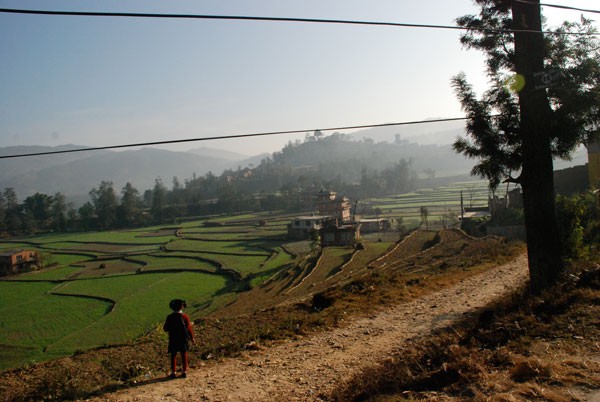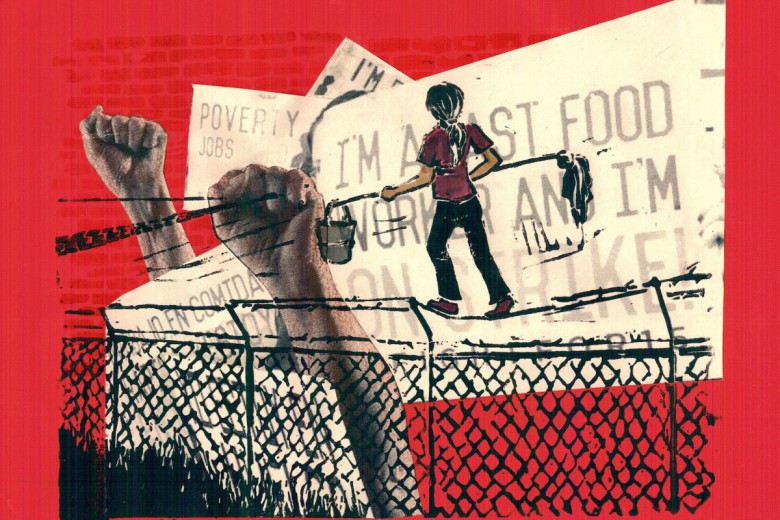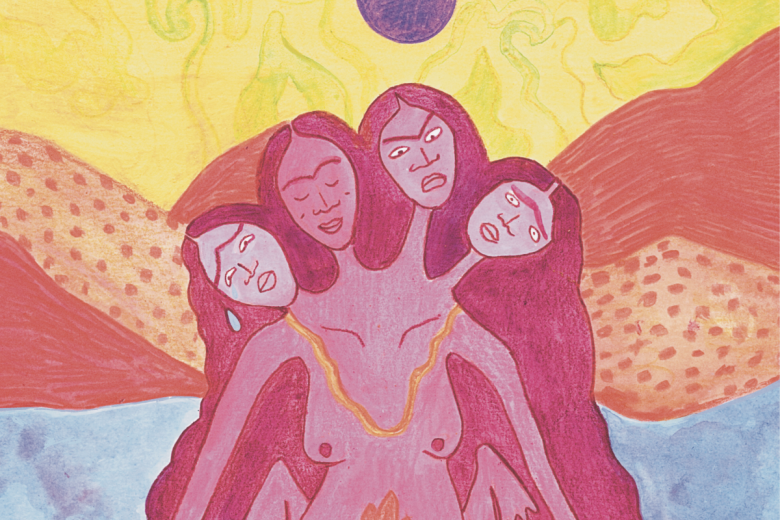
The small woman moves lightly across the concrete floor. Wearing socks and sandals, she carries glasses of mud-coloured milk tea, which she sets on an ankle-high table. There are no chairs in this room, so she kneels on the floor, waiting to speak.
The woman’s face is worn and crossed with lines pointing to a frown. She pulls a black shawl over her head for warmth, leaving only her damp, anxious eyes exposed. She looks old enough to be a grandmother, but guesses her age to be 26 or 27.
She has agreed to talk under a pseudonym – Muna – and she won’t consent to a photo. She works serving tea and cleaning at Shakti Samuha, an advocacy organization for survivors of trafficking like herself.
Her story began when, at the age of nine, she started working in a Bhaktapur carpet factory near Kathmandu where she received meals instead of wages. There was a man – a stranger – who repeatedly offered better work elsewhere. When Muna agreed to meet with him months later, she brought a friend for safety.
“The person had told them that they are going to his sister’s home for work,” translates Mira Dahal, program officer at Shakti Samuha.
“They had to go in the bus and the train for four or five days, and they are thinking, “˜where is the work?’”
The man eventually left, passing the girls off to men waiting at the next train station.
Not knowing how to get back home, Muna and her friend stayed with the men, eventually passing into India.
Days later, two women met Muna and her friend at a train station. Muna was never told which city she was in, and she was not literate enough to read the road signs.
Pulling the girls apart, the women explained that Muna and her friend had been sold. They must repay their debts, and work would start immediately.
The women at the train station were gharwalis – brothel owners.
A Nepali tsurki – a girl or woman sold into the sex trade against her will – fetches a price between 60,000 and 120,000 Indian rupees (about C$1,500 to C$3,000). The price can be several thousand rupees higher for Nepali virgins, who are commonly seen as more attractive than Indians and mysteriously believed to be able to cure AIDS through their virginity.
Gharwalis expect tsurkis to work off their selling price, though many, like Muna, are never told how much they were sold for. Terre des Hommes, an NGO advocating for children’s rights, estimates that brothel owners can make 20 times the tsurki‘s price if the tsurki stays healthy enough.
The tsurkis are heavily guarded to make sure they earn their worth. Usually this means 24-hour surveillance by a network of neighbours paid to snitch if the girls or women try to escape, and lockdown in a secure room until they are obedient enough to leave the brothel accompanied by a guard.
Terre des Hommes’s investigation found, though, that brothel clients are put off – even repulsed – at the thought of penetrating children. So perhaps Muna, still very much a child, didn’t fetch a high price.
Dahal nods her head as Muna describes the first brothel she was taken to, then she translates: “There were people even naked … seeing such things she was so much horrified and she couldn’t stop herself and all the time she was crying.”
Muna comes from a rural family that doesn’t speak Hindi. Her ignorance worked to the gharwali‘s advantage – she didn’t know how to escape or where to go if she did.
The brothels Muna describes are grim, ranging from bungalows to pinjaras. Bungalows are for middle-class men who are served a drink before choosing a woman from a lineup and following her to an upstairs apartment. The women are kept in by iron gates called “channel gates” that are virtually indestructible. Pinjaras are working-class brothels – mud-walled shacks with tin roofs. Girls linger at doorways calling out for clients, whom they take into a bed separated from the other clients and sex workers by a curtain.
“And the brothel owner had beaten her so much, and she is not ready to work,” Dahal says. Eventually Muna did work and, in some brothel’s bed between then and now, she contracted HIV.
Muna’s hands are suddenly on her face. She begins to shake, tears sliding between her fingers.
“She was just trying to say,” Dahal explains, “that one incident … old man came and four people tried to catch her hands and legs, and she couldn’t say any more than that. She just say, “˜I like to say, but I can’t.’”
In a brothel, the owners pay for rent, utilities, and food and clothing for sex workers. They also hire cleaning staff, boys to run errands, and guards. Tsurkis, like Muna, receive no salary.
It is said that when tsurkis repay their supposed debts, they are released. In reality, a tsurki is only released after she has become a financial burden. By the age of 18 to 22, many tsurkis are seen as too old and ill to bring in high profits.
When they’re released, tsurkis have few options: they can rent a room from the brothel owner and continue working, keeping half of their own wages. Or they can return to Nepal as an unskilled beggar or, like Muna, as a servant. Many are no longer welcome in their communities, and some are forcibly cast out.
Or the most popular option: they can work for themselves as sex workers. With enough money, they can purchase newly trafficked Nepali girls and open brothels of their own.
Nobody knows the exact number of people trafficked out of Nepal. But it is clear to NGOs working along the borders that the numbers are rising. Gharwalis must meet the demands of clients looking for what they describe as “fresh” girls.
Estimates range from between 5,000 to 12,000 Nepalis trafficked annually.
“At the district level it’s like a mafia,” says Pinky Singh Rana, her heels clicking on polished wood floors as she walks quickly from one meeting to another. She is the director of the Rural Women’s Development Community Centre in and around Kathmandu. For over a decade she has specialized in trafficking research.
Singh Rana says it is becoming eerily normal for Nepali girls to be taken from their villages. She recalls one research trip to a village in Terai, a district notorious for its missing girls. Researchers noticed an absence of girls walking on the streets. Villagers said the girls had gone to work.
“But where?” Singh Rana raises her hands and her voice as she speaks. “Work where? They have no idea where.”
“They are blind to the fact as to how the money is brought back. They keep themselves blind to that fact, I think.”
There are laws against trafficking in Nepal. Strict laws, in fact. Traffickers – buyers and sellers alike – face 20 years in prison with a 20-million-rupee fine if they’re caught. There is no chance for parole.
The trouble, according to Singh Rana, is that rural people don’t know the laws. And, in the aftermath of a 10-year civil war and in the midst of major electricity shortages sparking frequent protests, the year-old Maoist government has a lot of legal healing to do. In the midst of drafting a new constitution, trafficking is no more pressing than the flurry of other issues clamouring for political recognition – from caste discrimination to arms dealing.
Some NGOs focus their anti-trafficking work on finding and prosecuting traffickers. Maiti Nepal, for instance, is a vast, marble-floored rehabilitation centre funded by private donors and other NGOs, whose lawyers routinely travel to India bringing back Nepali tsurkis.
Upon her return to Nepal, the survivor is encouraged to lead Maiti Nepal’s lawyers and the police to the trafficker’s home, where he or she is arrested. Then the survivor is coached through the court process so she can convict her trafficker. These lawyers boast a 98 per cent success rate in their cases; fingered traffickers almost always end up in jail within a year.
However, women who have been trafficked by family members often don’t file cases. They’ve earned money for their family, and can’t afford to lose it.
And according to Singh Rana, cases never go to court without the background involvement of powerful NGOs. Survivors don’t know the laws, and they’ve often heard that their traffickers have links with Nepal’s corrupt police forces.
The rumours can’t be confirmed, but sources at Terre des Hommes generally agree that if police were doing their job, minors wouldn’t be trafficked.
“When they’ve been victimized … they’ll think twice about going to the police and reporting cases,” Singh Rana says.
“It’s too far for them, taking legal action,” she says. “It’s too far.”
Muna never tried to find her trafficker. She can’t even remember what he looked like.
Between 2001 and 2006, Nepal’s Supreme Court – the only court to hear cases of trafficking – convicted 11 traffickers.
Yet, convicting traffickers won’t stop the cyclical pattern of brothel economics.
Nepal’s courts have no jurisdiction over brothel owners in India, who are the root of trafficking. According to Muna Basnyat, anti-trafficking program coordinator at Terre des Hommes, it doesn’t matter how many traffickers are incarcerated. “As long as there is demand there will be supply.”
“We have to realize that trafficking is more a means of transportation,” Basnyat says. “The real trafficking begins when girls enter the brothels.”
According to Basnyat’s researchers, many clients have a preference for Nepali women because they are seen as polite, clean and reasonably priced. “And if you ask them, they’re always “˜about eighteen,’” she adds.
Because clients demand “new girls” – but not children – tsurkis sometimes live as servants in the brothel or the gharwali‘s home until they learn to behave as though they’re a little older. Before beginning sex work they learn Hindi, how to wrap themselves in saris, and to stand up straight.
“The men would still want underage girls if they didn’t lie about their age. This just makes them feel less guilty about what they’re doing,” says Basnyat.
The tsurkis are bonded with money they haven’t seen or touched, and their “debt” may incur interest as they move from brothel to brothel. These high profits from bonded labourers and client demand drives gharwalis to import trafficked girls.
It’s not just India importing Nepalis – it’s global, with accounts of Nepali women working in brothels as far away as South Africa. Urban or rural women from any given caste are sometimes duped into marrying traffickers. Others are drugged and taken to other parts of Nepal.
Little boys are promised a good education but end up in the circus, or village girls are lured into Kathmandu’s dance bars where they become targets for traffickers. Reports emerged last month of 500 or more Nepali girls and women who had allegedly been promised jobs in the Gulf States, but were instead trafficked into India.
“People keep harping, saying we’re trafficked because we’re poor,” says Basnyat. “I believe that’s one of the reasons, but not the only one.”
“I know there is a network and there is globalized crime,” she says. “There is a lot at stake for the people involved. I don’t know how many, but [some] very influential people.”
Because of Muna’s stubborn refusal to serve clients, she was sold to a second brothel. She stayed there for two years.
In that time, Muna’s small frame helped her hide from the police during four or five raids. “The brothel owner used to hide them sometimes in a box, sometimes inside the toilet, and sometimes under the bed with some cover,” says Dahal.
Then there was the rescue of 1996 – commonly called “the big one” by women’s advocates who remember it. In a large-scale operation, police waited until dark to simultaneously raid 50 brothels in a single hour. Over 400 sex workers presumed to be underage were detained in an Indian police shelter.
Muna was among them. The layers of clothes draping her body, designed to give her curves to add age, didn’t fool anyone. Police recognized that 13-year-old Muna had to get out of the brothel.
Muna lived in the police shelter for six months, but it was hardly an improvement over conditions inside the brothel. “The room was so worse, like it was a very small room, around 200, 300 women were in the same room and they would only get two rootis (bread), chapatis, rice and it was … not so much fresh, like it was stale,” relays Dahal.
The Nepali government refused to repatriate the girls, claiming they would spread immorality and AIDS.
NGOs were furious. Seven of them – including Maiti Nepal and Shakti Samuha (the group of women that would later find Muna) – united in a way NGOs haven’t since, lobbying the government tirelessly and setting up shelters for trafficked women.
It worked, and the women were allowed home, but not without a moralistic press frenzy at the airport. Their faces appeared on the covers of local newspapers the next day, extinguishing any hope they may have had of blending quietly back into the close-knit villages of Nepal’s hills.
“They brought us back,” Muna says through Dahal, “but the organization selected only the clever girls [to house in their own shelters]… . Girls like me were sent to the village, and even my parents were told I was trafficked.”
Muna’s return to her village triggered a community meeting, wherein it was decided that she should leave. With money from her family, she opened a hotel near the village.
She complains about people touching her breasts and throwing rocks at the hotel.
“Not only for being a trafficked woman,” she explains, “but [being] a woman. Because the community cannot see a woman living alone they start dominating, they start abusing.”
Muna met and befriended a man who didn’t know about her past. He eventually proposed marriage. She eventually accepted.
Before long, though, Muna was rejected by his family for being from a lower caste. Her in-laws locked her in a room for nearly a year and sent her husband to work in construction in the city.
Through hearsay, Maoists learned of Muna’s problem and took up her cause as part of their bloody battle for caste equality. They came to the home where she was being held to demand her freedom, threatening to kill her in-laws. Muna was released, and travelled to Kathmandu to join her husband. She found a job as a cleaner at a local school.
This was where workers at Shakti Samuha found her and eventually hired her to serve tea.
Muna now lives with her husband and seven-year-old daughter, but she remains pessimistic about the future. She can’t afford to send her daughter to school. And, after beginning daily drug treatments to control HIV, Muna had to tell her husband about the sex work of her past. Now he doesn’t work, and often gets violent when he drinks.
“My husband will not do any good to me,” she says. “So I have to feed him and he is doing nothing. But if I had nothing he would not support me.”
Muna stops to think, her brows creasing. “I am HIV positive… . If I am really not strong to work for myself, I am worried. Who will help me at that time?”
She sits quietly for a while, her question lingering unanswered in the concrete room.
She has stopped crying. With nothing more to add to her story, Muna nods at her translator, who gently dismisses her in Nepali.
Muna rises silently, delicately placing the teacups on a tray and lowering her eyes. The black shawl still hides her face. Then she slips out of the room in the ghostly, hollow way that servants do when the work is finished.






